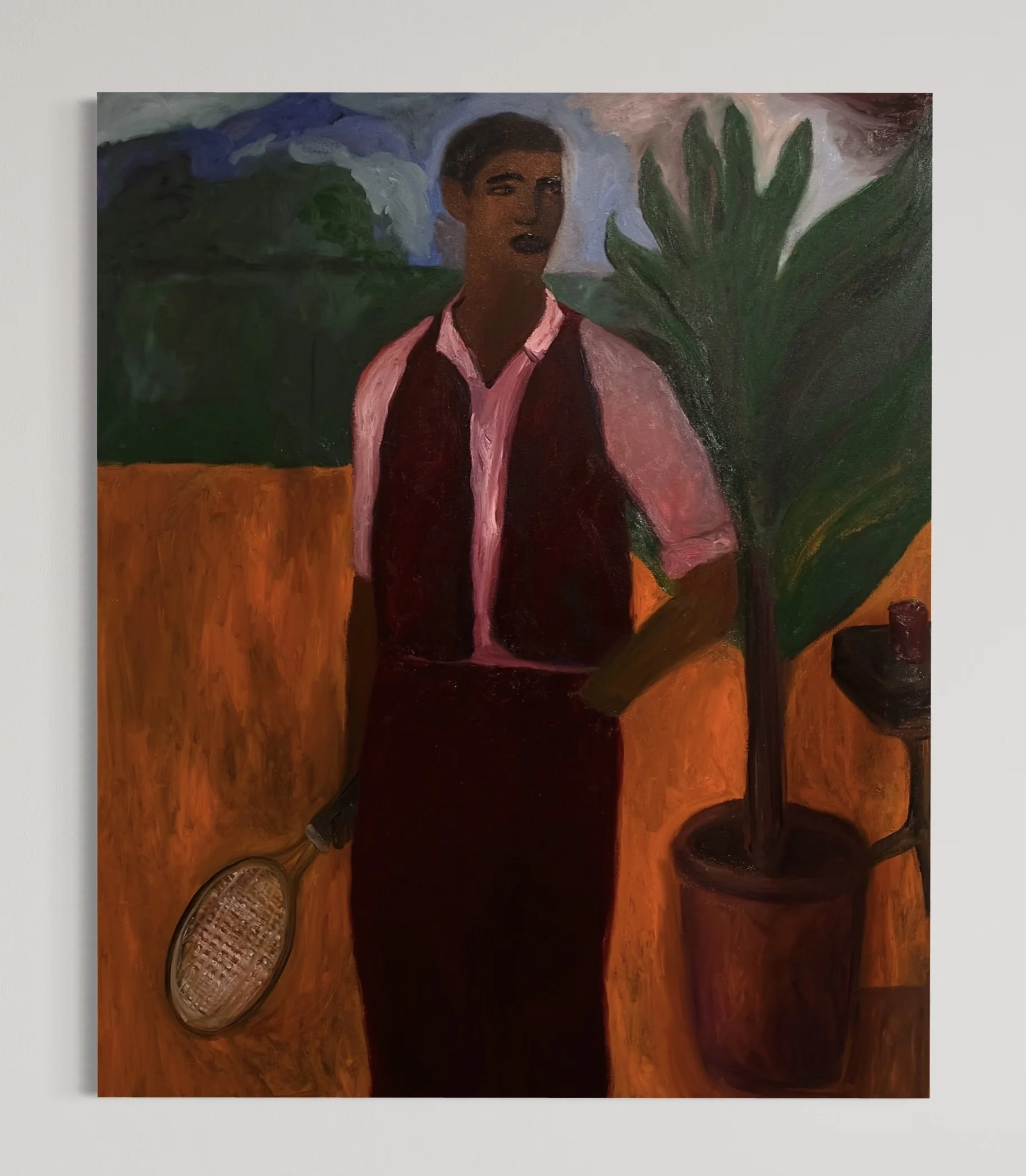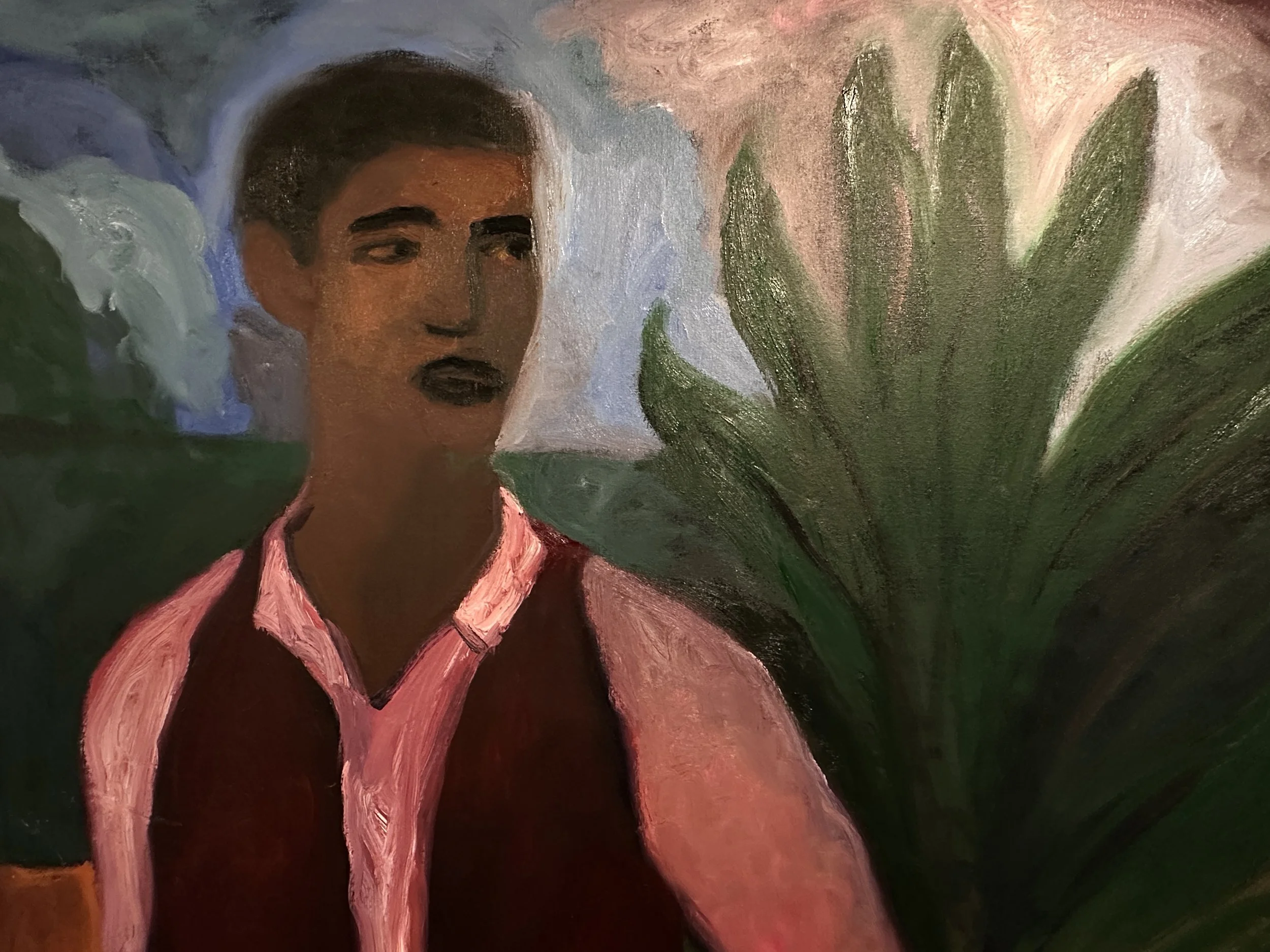
November 2025
Patrick Eugène
Caption
Artist Patrick Eugène on reclaiming Haiti’s legacy, painting as dialogue with ancestors, and keeping his studio practice fun.
Interview by Dan Golden
Dan Golden: I understand you worked in finance before shifting to painting. Was art always a part of your life in some way? What led you to make that transition, and how did it unfold?
Patrick Eugène: Yeah, I was in finance for a while, among other jobs, just doing what I had to do to make a living. Painting came in as a way to offset that nine-to-five grind. I needed something to balance life out, you know? I'd always been creative- heavily into music growing up, producing with friends, but painting was new. I started in my Brooklyn apartment, just me in a converted bedroom, trying to figure out how to put eyes and noses in the right place. It snowballed fast. I'd lose hours there, forget to eat, just completely locked in. Eventually, it went from a hobby to something I had to do all the time. That's when I knew I needed to give it everything.
DG: What draws you to the figure? Have you always felt a connection to figurative work, or did that connection emerge more gradually through your practice?
PE: The figure was just where I started; it was familiar. But for years, I was deep into abstraction, trying to figure out how to tell stories and pull out emotion without anything recognizable on the canvas. When I moved to Atlanta, I came back to figuration with everything I'd learned from that abstract period. Now, even when I'm painting people, it feels loose, open to interpretation, not locked down or overthought. That tension keeps it alive for me.
Image Caption
DG: If I'm correct, you work entirely from memory, no references, no sitters. Can you walk me through how a painting starts for you? How do your figures take form, and what guides their presence on the canvas?
PE: Yeah, it's all memory. We're all flooded with images every day, and they stick somewhere in the back of your head. I don't want a sitter or photo telling me what to do. I like letting the figures show up awkward, a little off, sometimes not perfectly proportioned. That's where the humanity is. I paint almost like I did when I was abstracting, moving things around, letting spirituality guide it, letting it flow until it feels right.
DG: Inside or outside the studio, what's been feeding you lately: music, books, art, people, ideas? Are there things you find yourself returning to creatively, or new influences that have surprised you?
PE: Music, always. Jazz is on heavy rotation in the studio. Conversations with my people keep me grounded and thinking. And then there's the weight of the times we're in politically and socially; it all feeds into the work. As a Haitian American, I feel a responsibility to speak to Haiti's story and spirit subtly. Recently, The Sweet Flypaper of Life by Roy DeCarava and Langston Hughes has been pushing me to imagine how my painting could sit in dialogue with their photography and poetry.
Image Caption
DG: Can you talk a bit about your recent Solitude show at Mariane Ibrahim, how that body of work came together, and what it explored for you? How do you see it connecting with the rest of your practice?
PE: Solitude was something I'd been thinking about long before COVID, the line between healthy introspection and isolation. My parents and my wife had similar experiences coming from Haiti to New York: excited about the opportunity but feeling locked inside these apartments, missing the community they knew back home. The pandemic just made the whole world live a version of that. The show was my way of exploring that feeling across generations.
DG: There's something timeless about your work, the palette, the posture, the quiet in it. Is that something you think about, or does it come naturally? And who are the artists or thinkers who've shaped the way you see and paint?
PE: I'm definitely an old soul. I love periods where things felt more intentional- music, design, family, community. Life today moves too fast to appreciate authentic craftsmanship. Photographers like Roy DeCarava and Gordon Parks capture that slower, soulful time, and I chase that feeling in color, in mood. Nostalgia is a big part of what I do.
Image Caption
DG: There's also an interesting contrast: your work often feels timeless, grounded in memory and quiet form, while your presence and personal style are distinctly contemporary. Is that tension something you think about, or do you see those worlds as connected in some way?
PE: It's just who I am, a New Yorker who grew up in the '90s, still got that in me, but I pull from older generations too. I'm not walking around dressed like it's the 1930s, but I borrow from that era. My work does the same thing: it holds onto what was meaningful about the past while living fully in the present.
DG: Your work spans from intimate pieces to larger, more monumental canvases. How do you think about scale when starting a painting or building a series?
PE: Scale depends on where I'm at physically and mentally. In big spaces, I go big, using my whole body. More minor works push me in different ways; it's harder to get the same emotion in that tight space. I like mixing it up to keep things fresh. Lately, I've been building my own frames and incorporating more sculptural elements. That opens up new ways to think about scale and presence.
Image Caption
Image Caption
DG: You've collaborated with brands like Dior. How do those projects relate to your studio practice? Do they feel like creative extensions or something entirely separate?
PE: It's definitely an extension of what I do. Working with Dior felt like taking my painting practice into another medium. There's a heavy history between France and Haiti, so to collaborate with a French luxury house was a chance to reclaim "Pearl of the Antilles" in a new way. I used Haitian materials like raffia and pearls alongside Dior's leathers and gold, abstracting Haiti's landscape and spirit into the design. It wasn't about putting a figure on a bag; it was about telling a story off the canvas.
DG: What was your entry point into the art world? How did you begin forging relationships with galleries or mentors that helped get your work out there?
PE: My first solo show was at a Brooklyn artist-run gallery. Friends from marketing and the art world pitched in, we got press, PBS came by, and NYU brought a class. It was grassroots, just building a community around that space. Over time, those relationships grew, new opportunities came, and I just stayed consistent, pushing myself, knowing there was nothing else I wanted to do.
Image Caption
Image Caption
Image Caption
DG: Who are you in conversation with now, whether creatively, personally, or conceptually? Anything or anyone shaping your thinking at the moment?
PE: My family, first, my wife and four boys, give everything I do a deeper purpose now. Beyond that, I'm surrounded by artists I respect and admire through my gallery, and that energy pushes me forward. Lately, that *Sweet Flypaper of Life* book keeps circling back, making me imagine what kind of collaborations are possible between painting, photography, and poetry.
DG: What's next, whether in the studio, on the road, or in your head?
PE: I want time to create without deadlines hanging over me to travel, take residencies, and really dive in. Long-term, I want to build a foundation in Haiti to support other artists and foster creativity there. In the meantime, I'm focused on pushing my practice further, bigger ideas, new materials, and new ways of telling stories.
Image Caption
“I truly believe I’m in conversation with ancestors. Somewhere down the line, there were artists in my family saying, ‘Hey, you got to carry this baton.’ That’s what it feels like.”
Link(s)
Patrick Eugène bio here.
Dan Golden is a Los Angeles-based designer and creative director, and the founder of Curator.







